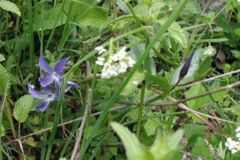| subsp. var.
|
|

|
| Habit:
|
|
[[Category:]]
|
| Height:
|
⇕
|
to
|
| Width:
|
⇔
|
to
|
|
|
cm
|
|
| Height:
|
⇕
|
cm to The wikipage input value is empty (e.g. <code>SomeProperty::, [[]]</code>) and therefore it cannot be used as a name or as part of a query condition.
|
| Width:
|
⇔
|
The wikipage input value is empty (e.g. <code>SomeProperty::, [[]]</code>) and therefore it cannot be used as a name or as part of a query condition. to The wikipage input value is empty (e.g. <code>SomeProperty::, [[]]</code>) and therefore it cannot be used as a name or as part of a query condition.
|
| Lifespan:
|
⌛
|
|
| Origin:
|
✈
|
|
| Poisonous:
|
☠
|
|
| Bloom:
|
❀
|
|
|
| Exposure:
|
☼
|
|
| Water:
|
◍
|
|
| Features:
|
✓
|
|
| Hidden fields, interally pass variables to right place
|
|
|
| Minimum Temp:
|
☃
|
°F
|
| USDA Zones:
|
|
to
|
| Sunset Zones:
|
|
|
| Flower features:
|
❀
|
|
|
|
|
| Standard Cyclopedia of Horticulture
|
|
Vinca herbacea, Waldst. & Kit. Hardy trailing glabrous herb, which usually loses its lvs. in winter: lvs. elliptical or lanceolate, rather obtuse, margins revolute; petiole very short: fls. more purple than the other species; calyx-lobes narrowly lanceolate, acuminate; corolla-lobes obovate, oblong-obtuse. E. Eu., Asia Minor. B.M. 2002. B.R. 301.
The above text is from the Standard Cyclopedia of Horticulture. It may be out of date, but still contains valuable and interesting information which can be incorporated into the remainder of the article. Click on "Collapse" in the header to hide this text.
|
| Vinca herbacea {{{status}}} Fossil range: {{{fossil_range}}}
|

Vinca herbacea leaves and flowers
|
| Plant Info
|
| Common name(s):
|
|
{{{common_names}}}
|
| Growth habit:
|
|
{{{growth_habit}}}
|
| Height:
|
⇕
|
{{{high}}}
|
| Width:
|
⇔
|
{{{wide}}}
|
| Lifespan:
|
⌛
|
{{{lifespan}}}
|
| Exposure:
|
☼
|
{{{exposure}}}
|
| Water:
|
☂
|
{{{water}}}
|
| Features:
|
❀
|
{{{features}}}
|
| Poisonous:
|
☠
|
{{{poisonous}}}
|
| Hardiness:
|
❆
|
{{{hardiness}}}
|
| USDA Zones:
|
|
{{{usda_zones}}}
|
| Sunset Zones:
|
|
{{{sunset_zones}}}
|
|
| Scientific classification
|
| Domain:
|
{{{domain}}}
|
| Superkingdom:
|
{{{superregnum}}}
|
| Kingdom:
|
Plantae
|
| Subkingdom:
|
{{{subregnum}}}
|
| Superdivision:
|
{{{superdivisio}}}
|
| Superphylum:
|
{{{superphylum}}}
|
| Division:
|
Magnoliophyta
|
| Phylum:
|
{{{phylum}}}
|
| Subdivision:
|
{{{subdivisio}}}
|
| Subphylum:
|
{{{subphylum}}}
|
| Infraphylum:
|
{{{infraphylum}}}
|
| Microphylum:
|
{{{microphylum}}}
|
| Nanophylum:
|
{{{nanophylum}}}
|
| Superclass:
|
{{{superclassis}}}
|
| Class:
|
Magnoliopsida
|
| Sublass:
|
{{{subclassis}}}
|
| Infraclass:
|
{{{infraclassis}}}
|
| Superorder:
|
{{{superordo}}}
|
| Order:
|
Gentianales
|
| Suborder:
|
{{{subordo}}}
|
| Infraorder:
|
{{{infraordo}}}
|
| Superfamily:
|
{{{superfamilia}}}
|
| Family:
|
Apocynaceae
|
| Subfamily:
|
{{{subfamilia}}}
|
| Supertribe:
|
{{{supertribus}}}
|
| Tribe:
|
{{{tribus}}}
|
| Subtribe:
|
{{{subtribus}}}
|
| Genus:
|
Vinca
|
| Subgenus:
|
{{{subgenus}}}
|
| Section:
|
{{{sectio}}}
|
| Series:
|
{{{series}}}
|
| Species:
|
V. herbacea
|
| Subspecies:
|
{{{subspecies}}}
|
|
| [[{{{diversity_link}}}|Diversity]]
|
| {{{diversity}}}
|
| Binomial name
|
Vinca herbacea
Waldst. & Kit.
|
| Trinomial name
|
{{{trinomial}}}
|
| Type Species
|
{{{type_species}}}
|
| {{{subdivision_ranks}}}
|
|
|
[[Image:{{{range_map}}}|{{{range_map_width}}}|]]
|
| Synonyms
|
| {{{synonyms}}}
|
Vinca herbacea (Herbaceous Periwinkle) is a flowering plant native to eastern and southeastern Europe, from Austria south to Greece, and east to the Crimea, and also in southwestern Asia east to the Caucasus and Alborz mountains. It grows mainly in steppe habitats.
It is a herbaceous perennial growing as a trailing vine, spreading along the ground and rooting along the stems to form clonal colonies, growing up to 10-20 cm high. The leaves are opposite, lanceolate, 1-5 cm long and 0.2-3 cm broad, glossy green with an entire margin, and nearly sessile with only a very short petiole. The flowers are produced in late summer, blue-violet or occasionally white, 2.5-3.5 cm diameter, with a five-lobed corolla.
Cultivation and uses
It is occasionally grown in temperate gardens as a rock garden plant.
References

